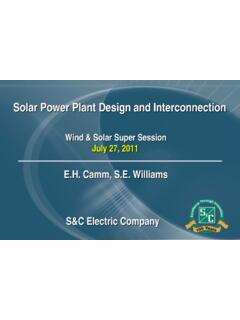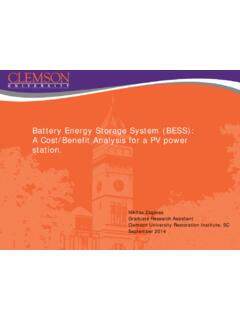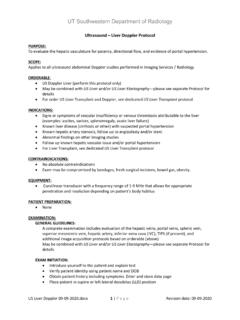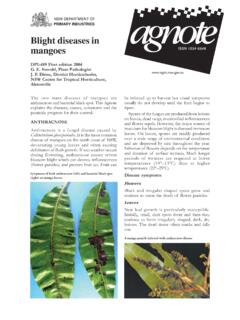Transcription of TANK DESIGN & DETAILING Introduction
1 TANK DESIGN & DETAILINGI ntroductionThe API 650 standard is designed to provide the petroleum industry with tanks of adequate safety and reasonableeconomy for use in the storage of petroleum, petroleum products, and other liquid products commonly handled andstored by the various branches of the industry. This standard does not present or establish a fixed series ofallowable tank sizes; instead, it is intended to permit the purchaser to select whatever size tank may best meet hisneeds. This standard is intended to help purchasers and manufacturers in ordering, fabricating, and erecting tanks ; itis not intended to prohibit purchasers and manufacturers from purchasing or fabricating tanks that meetspecifications other than those contained in this standard has requirements given in two alternate systems of units.
2 The requirements are similar but notidentical. These minor differences are due to issues such as numerical rounding and material supply. Whenapplying the requirements of this standard to a given tank, the manufacturer shall either comply with all of therequirements given in SI units or shall comply with all of the requirements given in US Customary units. Theselection of which set of requirements (SI or US Customary) shall apply to a given tank shall be by mutualagreement between the manufacturer and of tanks (based on Roof fixing) Roof Roof TankTypes of Tank based on RoofTypes of Floating Roof Floating Roof Floating Roof TankMani Parts of chairs and Anchor bolt of man man & Secondary Wind angle or compressen w Structures and support pipe man way rungs and internal ladder with support cage Ladder and spiral Staircase ladders and platforms with support handrailsFor Floating Roof Deck or single or plate & rim man man wayStandards.
3 API Standard 650, Welded Steel tanks for Oil StorageAPI Standard 620, Recommended Rules for DESIGN and Construction of Large Welded LowPressure Storage TanksAPI RP 2000, Venting Atmospheric and Low Pressure Storage TanksStandard Selection conditions:Atmospheric pressure no refrigerated tanks shall be designed to API 650. Closed Top subjectto low pressure shall additionally satisfy Appendix pressure tanks up to 15 psig shall comply with API 620 and shall include all API 650requirements for materials and 650 tanks with wall thickness up to and including inch shall be to Appendix A exceptthat Group I materials of Table 2-3 shall not be used below assembled API 650 tanks shall comply with Appendix J except that a minimum of spotradiography shall be applied with joint efficiency of TANK GA PREPARATION:1.
4 Fix the layout for tank overall dimensions in elevation, top view and side Compare the overall dimensions and reference dimensions3. To draw all the attachments and tank parts should be maintain completely 1:1 scale4. Put all the orientation for Man ways , draw of sump, Nozzles and internal and external ladderclips, earthing boss or Clips, wind girder, lightning clips, piping support clips and All nozzle sizes and standards, schedules, type of flanges to be used, type of faces to Be used in flanges, if required any blind flanges, Davit Man ways, hinged type man ways,Vent and all nozzle elevation should be Fixed in Bottom of tank (bottom of shell plate). Theseitems should be come in nozzle General notes, assembly notes are added in Which type of materials used in tank and attachment parts is come in material of Add the DESIGN notes in DESIGN Data table9.
5 Total weight of the tank and centre of gravity should be If any internal (or) external surface preparation is there, this notes also Client gives any standards to be follow the tank DETAILING , that standard also should Give the Standard requirements12. If any tolerance given, that is also added in overall dimensions13. Structural also added in the GA If any legends there these items also includeMajor dimensions specified in GA total plate thickness in via any wind girder is there that elevation should be orientations and ladder positions (internal or external), ladder clipsAnd piping supports, all attachments. elevations (X,Y) minimum two Roof Nozzle there, that case angel and distance for center line of column to column distances overall length for OrientationSURFACE PREPARATION AND PAINTING: (Example)SURFACE PREPARATION AND PAINTINGD esign Data(example):NOZZLE DATAS: (Example)STANDARDS, SPECIFICATIONS: (Example)MATERIAL OF CONSTRUCTION: (Example)Pressure ratingDesign pressures up to 500 mbar.
6 Non-pressure, up to 10 mbarLow-pressure, up to 25 mbar High-pressure, up to 60 mbarVery high-pressure, up to 500 mbarMaximum negative pressure = -20 for negative pressure = up to mbarTemperature range is from 300 C down to -40 DEVELPOMENT DRAWINGV ertical Joints in ShellButt joints with complete penetration and complete fusion as attained bydouble Welding or by other means which will obtain the same quality of jointHorizontal Joints in ShellComplete penetration and complete fusion butt to Bottom Plate JointContinuous fillet weld laid on each side of the shell plate. The size of each weldshall be the thickness of the thinner plate development detail (use pi * D formula, D is mean dia of tank) layout plate to Annular plated welding plate to Shell plate (longitudinal and circumference)
7 Welding Girder to shell plate welding Girder to Wind girder welding angle to shell plate welding of Views for plate to plate welding detailsShell plate Development Drawing involved od and Rf pad od locations and way od and man way Rf pad od locations and clean out Boss or clips locations and overall clips, Piping supports clips (X or Y dimension and plate weld line to clip Girder positions and welding angle and external ladder clips locationsShell course DESIGN details one foot method(example)Allowable steel stresses:To keep the selection of shell plate material within the band ofcarbon and carbon manganeseweldable steels the maximum allowable DESIGN stress which may be used is 260 N/mm2 or twothirds of the material, specified minimum yield strength at room temperature, whichever is thelower.)
8 This limit of 260 N/mm'discourages the use of steels with a minimum specified yield strength in excess of390 N/mm2,because of their increased hardness and reduced weldability.(CL , TABLE & CL Note:1of API-650)tt = D ( )/St - Hydro test thicktd = D ( )G/Sd + CA DESIGN calculated Dia of tankH DESIGN Liquid levelG Specific gravity of liquidSd 2/3 of yield stress 2/5 of tensile stressLess value only takenSt 3/4 of yield stress 3/7 of tensile stressLess value only takenThickness of the bottom course or ring, which is restricted by API 650 to amaximum of1 course(Number fromBottom most)ConsideredMaterialSpecificationHtof Course (m)AssumedThickness (mm)NominalTank Dia (m)Ht fromBottom ofCourses toBottom ofoverflownozzle (m) Sd(Mpa)( )(mm) (mm)HydrotestThick(mm)ProvidedHt(m)xThk.
9 (mm)courseFirst (Bottommost)S355 J 2 G 3 FF J 2 G 3 FF J 2 G 3 FF JRG 2 FN JRG 2 FN JRG 2 Dimensions angles to weld distance (longitudinal and circumference) Gap (longitudinal and circumference) positions angles and and all types of clips positions and details should be maintain weld sizes, welding angles, which type of weld shouldbe no. in all plates, curb angle, all attachment clips with out nozzle and nozzle any legends there these items also includeBOTTOM PLATE DEVELOPMENTB ottom PlatesSingle-welded full-fillet lap joint or single-welded butt joint with backing bottom plates shall project at least 1inch width beyond the outside edge of the weldattaching the bottom to shell plate development layout to plate welding plate welding plate to Annular plate and Back strip welding Views for plate to plate welding of NotesDESIGN OF BOTTOM PLATE.
10 (CL of API-650) and BS 2654 Bottom plate thickness = 6mm + plate thickness forStainless steel tanksLap welded bottom plate = 5tmmBut welded bottom plate = 3mmMin plate thickness forCarbon steel tanksLap welded bottom plate = 6mmBut welded bottom plate = 5mmDESIGN OF ANNULAR PLATE:(CL & Table of API-6500)Hydrostatic Stress x D x H - (example) = < 210 (210 is material allowable stress in DESIGN temperature) Hydrostatic Stress < 210 MpaAnnular Plate Thickness provided = 12mmAnnular plate width(CL of API-650)Annular plate radial width = 215tb/ (HG) radial width will be maintain 600 mm as per Cl = Thickness of the annular plate in mmH = Maximum DESIGN liquid levelG = DESIGN specific gravity of the liquid to be storedMajor Dimensions developed course of Bottom plate to middle plate fixing dimensions(vertical & horizontal)






